How to make do-it-yourself stretch ceilings without heating?
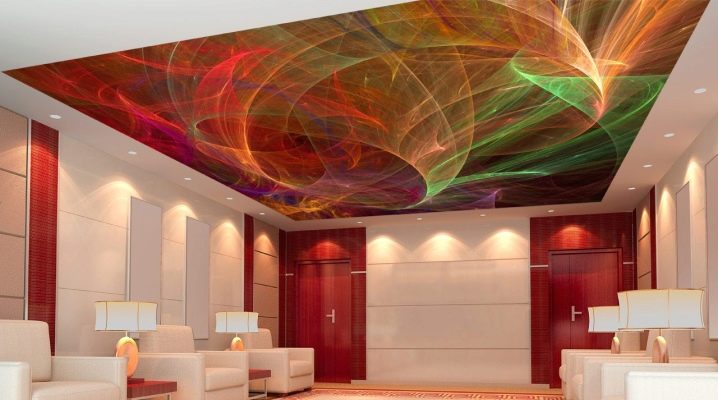
Before renovating apartment owners, the question of whether it is possible to install stretch ceilings on their own begins to wonder. It turns out that such work can be done with your own hands. You just need to have the appropriate skills, as well as have special tools in the arsenal.
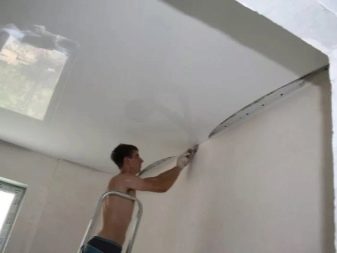

Varieties
The most popular and demanded glossy ceiling designs. These canvases are made in the RAL color chart of the table. This type of ceiling is multi-colored or two-color. The mirror surface of the canvas reflects individual furnishings, thereby visually increasing the space of the room. The visible seam left by the welding of individual strips is attributed to the lack of a glossy ceiling.

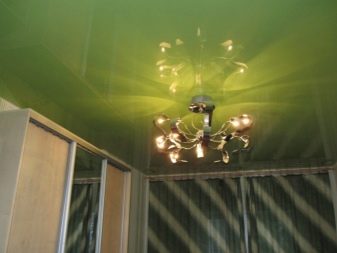
The matte construction is a classic look. This type of canvas will not reflect light reflections, so the material will more clearly convey the selected shade. The matte surface of the surface will not attract much attention, therefore, creating an interior, you can place accents in the room on the objects of the environment itself.


Satin ceilings are very similar to matte structures. This type of ceiling structure has an ideal smooth plane. One gets the impression that the canvas is of deep saturated color. The material makes it possible to better reflect color tones. Welding seams remain virtually invisible.


If you need to stretch a fabric made of breathable material, choose a fabric fabric. In terms of external parameters, it is quite difficult to distinguish the textile type from matte. The main nuance here is the degree of tension. The smooth surface of the ceiling is even, there is also a relief type of surface.

When choosing a textile product when installing a structure with your own hands, it should be borne in mind that such a material is created from polyester thread or from ordinary fabric, this affects the throughput of the canvases.
Fastening methods
There are several methods for attaching stretch ceilings.
Wedge method
Self-installation of tensioning structures can be greatly simplified if using the wedge fastening method. With this option, the canvas is tightly fixed into the baguette using a spacer bar. Further, the gap between the ceiling and walls is covered with a plinth. This method is considered quite convenient, because the material does not need to be glued in accordance with the existing configuration of the room.
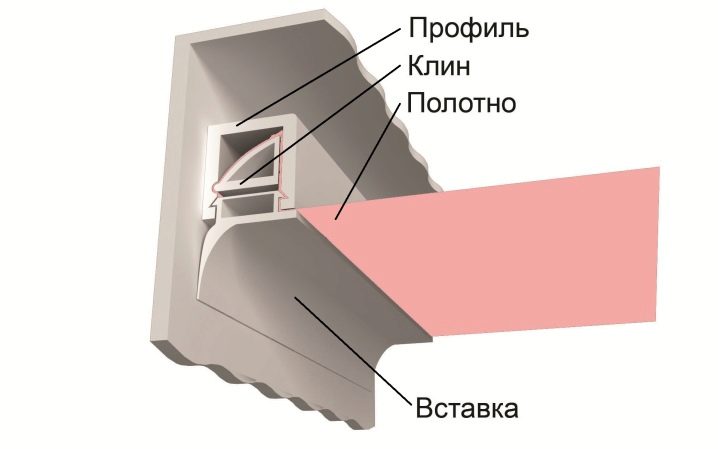
At the end of gluing, the remaining material (i.e. excess) is removed with a construction knife.
Cam method
There will be no need to make any special cutting. Usually the canvas is fixed between a movable baguette element and a fixed one. Such elements are also called cams. Often this installation option is used for inserts, the square of the ceiling in this case should not be more than 20 sq. m, in a different way the vinyl sags and begins to pull out of the profile.

Harpoon method
This method is best used when there is a high probability of permanent leaks from the apartment above the floor. In this case, the design will have to be disassembled. That is why the harpoon order of the tensioning structures should be chosen. Only this method will make it possible to dismantle the ceiling system completely, with the possibility of fixing the same canvas again.
The disadvantage of the harpoon method is the long-term installation of the ceiling. Here you will have to make an exact pattern of the material. Cutting out requires special equipment. This method is considered the most reliable and practical. If you do not pay attention to the long installation time of the entire structure.
According to the instructions, after completing the fixing of the baguette when installing the tensioning fabric, then you should proceed to the wiring of the electrical wires.

The baguettes are installed for a long time, so there is no need to allow the existence of linear twists, meanwhile the wire is hidden in a separate cable channel fixed at the base.
DIY stretch ceilings without heating
There are different types of stretch ceiling structures, some are installed without using heat guns. If a person has at least some experience in interior decoration of a room, he will be able to master the technology of installing the ceiling in a "cold" way. You can safely take up work after studying the theory.

PVC film not only reflects light, the material perfectly retains a large volume of water, while being completely unpretentious in maintenance. The existence of a serious flaw can still discourage the desire to install a PVC ceiling. To stretch such a surface, you will have to heat the room to a high temperature.


There are several primary reasons why it is better not to heat the room:
- Before the temperature effect on the room, it is necessary to completely free the room from furniture and finishing materials. Under the influence of high temperature, objects in the room are deformed. Unfortunately, repair work is not always carried out in a complex manner, therefore, in a renovated room it is better to stretch a fabric ceiling, which does not require special heating during installation.
- Heat gun. Running a heat gun will be costly. It is cheaper to install the ceiling with your own hands.
- Installing a tensioning structure without heating is cheaper and much safer. Because the unreliability of the company that is contacted for the installation of the ceiling can manifest itself in the use of faulty old equipment. And this sometimes leads to accidents when installing the ceiling using a heat gun.
- Only professionals can competently use the heat gun after completing specialized training. Such training is undergone by every master in the production of stretch ceiling structures. It will be possible to install the canvas yourself without heating only if you follow the instructions.


Stretch ceilings: pros and cons
Installing a ceiling structure without heating has advantages and disadvantages. However, like other types of interior decoration. By the way, this option has much more advantages.
Arguments against mounting ceiling structures by this method are:
- Price. The price of fabric canvases significantly exceeds the cost of the film. This disadvantage can be compensated for by self-installation of the ceiling structure. Allowing you to save on payment for the work of specialists.
- Large-scale flooding will lead to damage to the fabric, which will have to be replaced because of this. Accordingly, in an apartment where leaks occur constantly, it is better not to make a choice in favor of fabric.
- In rooms with high levels of humidity, there are installation restrictions. For example, in a sauna or bathroom, the fabric is simply not stretched. It is not recommended to install such a ceiling in the kitchen either. The material will easily absorb moisture and a variety of food odors, while leaving an unpleasant odor and colored spots.


Installing a high-quality hood, of course, can help and rid the room of accumulated moisture and odor.
If you need to install a ceiling in the living room or bedroom, then it is better to choose a fabric cloth. Such a ceiling structure is installed using the "cold" method. This choice will become the most correct one.
Installation of a fabric ceiling has considerable advantages:
- installation on your own is possible;
- long operational life;
- resistance to mechanical stress;
- lack of seams;
- possible application of paint, photo printing;
- the room does not need to be freed from pieces of furniture;
- smooth matte smooth surface.


Self-installation instructions
For independent work in the process of installing the ceiling, the skills of home repair work will come in handy. Ceiling alone cannot be installed. For such work, several people are needed.
To design a fabric ceiling, you need to go through important steps:
- The required canvas is ordered for a certain size of the room. It is necessary to call a measurer who will take all the necessary measurements.
- Next, a baguette is attached. Aluminum profiles are attached around the entire perimeter of the ceiling.
- The canvas is attached to the baguette with special clips.
- To eliminate irregularities in the attachment areas, a construction hair dryer is used, if this is not the case, you can use a regular household hair dryer.
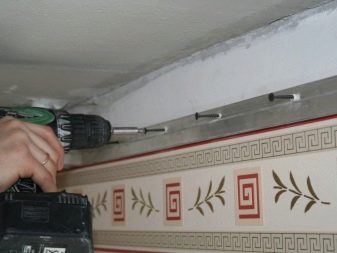

In fact, the installation work is not difficult. It is important to approach the process itself responsibly in order to get the desired result.
Reviews
It is much easier to install a seamless fabric ceiling structure if you use special technology. Reviews of real people will help to understand the details. Those who have experience and know how to install stretch ceiling structures.

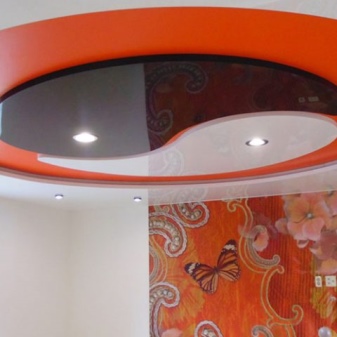
In the reviews, experienced people talk about self-mounting without heating.
You can glean the following information:
- Installation of a fabric ceiling is easier than installing PVC. There is no need to use a cannon here, the installation should start from the middle of the room, not from the corners. Otherwise, the system remains the same.
- In order not to damage the expensive material of the ceiling structure, before starting the installation work, you should carefully study the installation technology. Experienced specialists will tell you about the intricacies and secrets. It is necessary to understand exactly how the installation of the ceiling sheet is carried out, and only then proceed to business on your own.
- You need to work with a spatula carefully so as not to damage the fabric. The material, of course, is strong enough, and yet it is not worth tucking in too sharply, since the risk of ruining the fabric is still present.
See below for cold ceiling installation.













The comment was sent successfully.